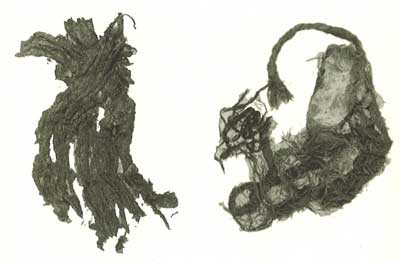
Avery Island Louisian
Pieces of twisted fiber cordage and fragmentary textile remains were recovered on Avery Island in Iberia Parish, Louisiana, during the excavation of a salt mine shaft. The unique saline conditions found in this area of Avery Island, 23 to 32 feet below the surface of the ground, preserved these textile remains along with other normally perishable prehistoric plant materials. The earliest textile specimen dates to 2800 B.C. and is the oldest known flexible fabric from Louisiana and among the oldest in the Southeast. Both interlacing and twining were used in textile construction. An example of twill plaited, rigid split-cane basketry or matting dates to ca. 2300 B.C.

Detail of twined fragment (ca. 2600 B. C.) and cordage attached to a salt plug from Avery Island.
![]()
LSU Textile & Costume Museum
140 Human Ecology Building
Department of Textiles, Apparel Design, and Merchandising
College of Agriculture
Louisiana State University
Baton Rouge, LA 70803
Telephone: (225) 578-5992 and 578-2281
Fax (225) 578-2697
Contact us
Arnold Research Cave Missouri | Avery Island and Louisiana | Bayou Jasmine Louisiana | Rattlesnake master plant | Footwear Photos |Credits | Past Exhibitions